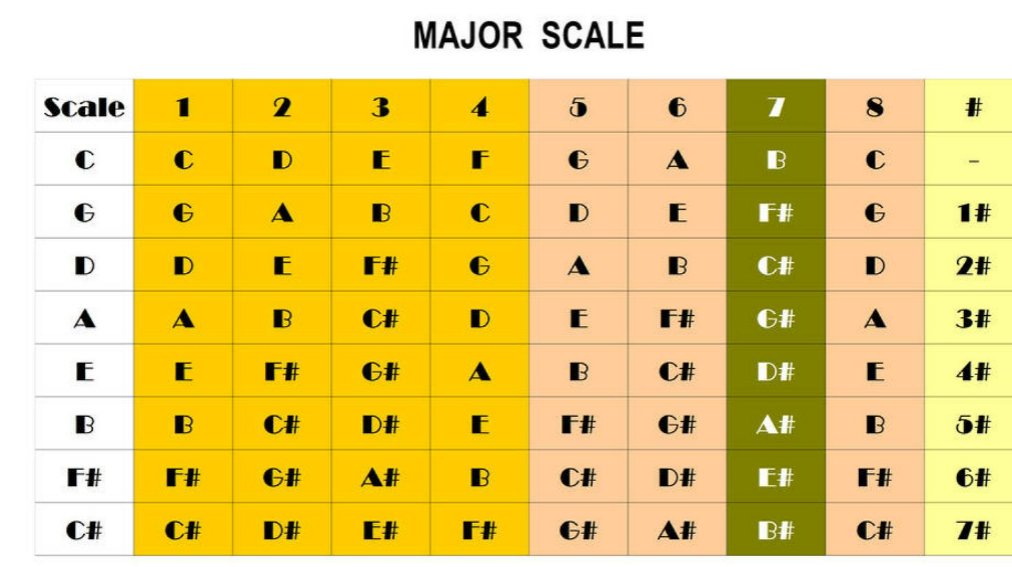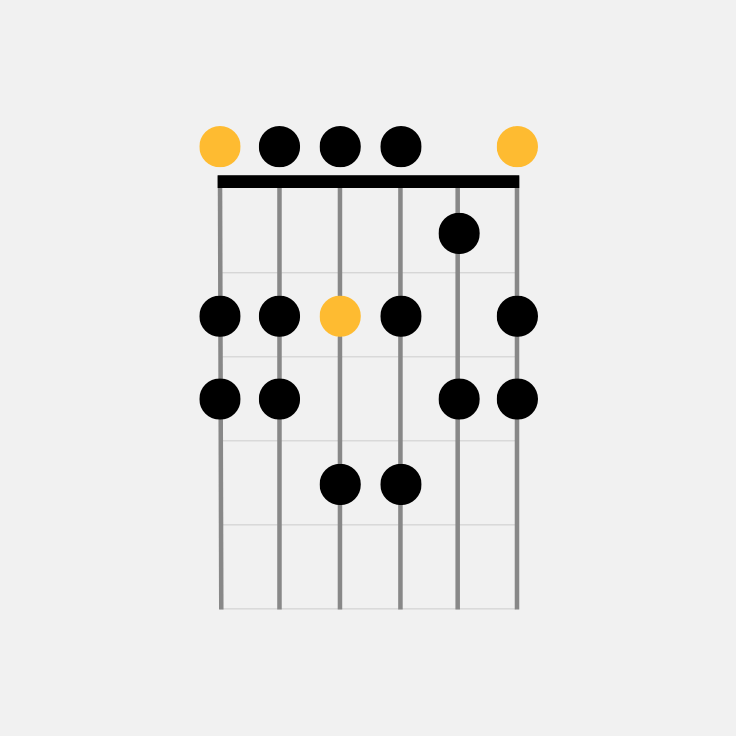Why the Major Scale Matters: Exploring the Basics of
Par un écrivain mystérieux
Last updated 29 mai 2024

Music theory is a complex and fascinating subject that can seem confusing at first glance. However, understanding the major scale is a great place to start. The major scale is the foundation of Western music and serves as a reference point for many other scales and modes.The major scale consists of seven notes arranged in a specific pattern of whole steps and half steps. The pattern of whole and half steps for a major scale is: whole, whole, half, whole, whole, whole, half. This pattern can also be represented as a series of intervals, which are the distances between the notes. The intervals for a major scale are: 1, 2, 3, 4, 5, 6, 7. To build a major scale, you can start on any note and follow the pattern of whole and half steps. On the guitar, each fret space
Music theory is a complex and fascinating subject that can seem confusing at first glance. However, understanding the major scale is a great place to start. The major scale is the foundation of Western music and serves as a reference point for many other scales and modes.The major scale consists of seven notes arranged in a specific pattern of whole steps and half steps. The pattern of whole and half steps for a major scale is: whole, whole, half, whole, whole, whole, half. This pattern can also be represented as a series of intervals, which are the distances between the notes. The intervals for a major scale are: 1, 2, 3, 4, 5, 6, 7. To build a major scale, you can start on any note and follow the pattern of whole and half steps. On the guitar, each fret space represents a half step. Starting on the 3rd fret on the 5th string, let's build a C major scale. Following our C note at the 3rd fret, take a whole step to D, another whole step to E, a half step to F, a whole step to G, another whole step to A, a whole step to B, and a half step back to C. The resulting scale is: C, D, E, F, G, A, B, C.One of the most important aspects of the major scale is its relationship to chords. Chords are groups of three or more notes played together, and they are the building blocks of harmony in music. Each note in a major scale corresponds to a specific chord, and these chords are often used together to create harmonic progressions.The chords in a major scale follow a specific pattern, known as the diatonic chord progression. This progression is based on the intervals of the major scale, and it can be represented by Roman numerals. The Roman numerals represent the degree of the scale that each chord is built on. For example, in a C major scale, the I chord is C, the IV chord is F, and the V chord is G.The diatonic chord progression for a major scale is: I, ii, iii, IV, V, vi, vii°. The lowercase Roman numerals represent minor chords, while the uppercase Roman numerals represent major chords. The vii° represents a diminished chord, which is built on the seventh degree of the scale.By understanding the major scale and its relationship to chords, you can begin to analyze and understand the harmony in music. This knowledge can help you to compose your own music, improvise, and appreciate the music you listen to on a deeper level.In conclusion, the major scale is a fundamental building block of Western music. Understanding its pattern of whole and half steps, its intervals, and its relationship to chords is essential for anyone interested in learning music theory. By starting with the major scale, you can begin to explore the rich and fascinating world of music theory.
Music theory is a complex and fascinating subject that can seem confusing at first glance. However, understanding the major scale is a great place to start. The major scale is the foundation of Western music and serves as a reference point for many other scales and modes.The major scale consists of seven notes arranged in a specific pattern of whole steps and half steps. The pattern of whole and half steps for a major scale is: whole, whole, half, whole, whole, whole, half. This pattern can also be represented as a series of intervals, which are the distances between the notes. The intervals for a major scale are: 1, 2, 3, 4, 5, 6, 7. To build a major scale, you can start on any note and follow the pattern of whole and half steps. On the guitar, each fret space represents a half step. Starting on the 3rd fret on the 5th string, let's build a C major scale. Following our C note at the 3rd fret, take a whole step to D, another whole step to E, a half step to F, a whole step to G, another whole step to A, a whole step to B, and a half step back to C. The resulting scale is: C, D, E, F, G, A, B, C.One of the most important aspects of the major scale is its relationship to chords. Chords are groups of three or more notes played together, and they are the building blocks of harmony in music. Each note in a major scale corresponds to a specific chord, and these chords are often used together to create harmonic progressions.The chords in a major scale follow a specific pattern, known as the diatonic chord progression. This progression is based on the intervals of the major scale, and it can be represented by Roman numerals. The Roman numerals represent the degree of the scale that each chord is built on. For example, in a C major scale, the I chord is C, the IV chord is F, and the V chord is G.The diatonic chord progression for a major scale is: I, ii, iii, IV, V, vi, vii°. The lowercase Roman numerals represent minor chords, while the uppercase Roman numerals represent major chords. The vii° represents a diminished chord, which is built on the seventh degree of the scale.By understanding the major scale and its relationship to chords, you can begin to analyze and understand the harmony in music. This knowledge can help you to compose your own music, improvise, and appreciate the music you listen to on a deeper level.In conclusion, the major scale is a fundamental building block of Western music. Understanding its pattern of whole and half steps, its intervals, and its relationship to chords is essential for anyone interested in learning music theory. By starting with the major scale, you can begin to explore the rich and fascinating world of music theory.

The Major Scale: Why and How

Sleep Matters: The Impact Of Sleep On Health And Wellbeing

How to Read Sheet Music: A Step-by-Step Guide – Musicnotes

21 Different Types of IT Careers To Explore

What is dark matter?

The Major Scale Explained

Basic Music Theory for Beginners – The Complete Guide

Theoretical Research: Definition, Methods + Examples
Why is the major scale the way it is? Further, why are notes
Recommandé pour vous
- Digital Glass Scale with Stainless Steel Accents Clear - Taylor14 Jul 2023
 CGOLDENWALL Precision Lab Scale Digital Analytical Balance Laboratory Balance Jewelry Scale Scientific Scale 0.01g Accuracy 110V (5000g, 0.01g)14 Jul 2023
CGOLDENWALL Precision Lab Scale Digital Analytical Balance Laboratory Balance Jewelry Scale Scientific Scale 0.01g Accuracy 110V (5000g, 0.01g)14 Jul 2023 The 2 Best Bathroom Scales of 202414 Jul 2023
The 2 Best Bathroom Scales of 202414 Jul 2023 44 lb. Stainless Steel Scale14 Jul 2023
44 lb. Stainless Steel Scale14 Jul 2023- File:Balanced scale of Justice.svg - Wikipedia14 Jul 2023
 High Precision (0.1g) Digital Mini Scale - Easy Composites14 Jul 2023
High Precision (0.1g) Digital Mini Scale - Easy Composites14 Jul 2023 Balance scale isolated icon Royalty Free Vector Image14 Jul 2023
Balance scale isolated icon Royalty Free Vector Image14 Jul 2023 MULTICOMP PRO BAL1 WEIGHING SCALE, PRECISION, 0.001G, 50G ROHS COMPLIANT: YES14 Jul 2023
MULTICOMP PRO BAL1 WEIGHING SCALE, PRECISION, 0.001G, 50G ROHS COMPLIANT: YES14 Jul 2023 5 Essential Guitar Scales For Beginners14 Jul 2023
5 Essential Guitar Scales For Beginners14 Jul 2023 Economies of Scale - Definition, Effects, Types, and Sources14 Jul 2023
Economies of Scale - Definition, Effects, Types, and Sources14 Jul 2023
Tu pourrais aussi aimer
 Bandeaux de Sport pour Hommes Pack de 6, Bandeaux d'Entraînement d'Évacuation de l'Humidité pour Courir le Cyclisme Basket-Ball Football de Tennis, Bandeau Extensible pour Hommes Non Glissement pour les Garçons14 Jul 2023
Bandeaux de Sport pour Hommes Pack de 6, Bandeaux d'Entraînement d'Évacuation de l'Humidité pour Courir le Cyclisme Basket-Ball Football de Tennis, Bandeau Extensible pour Hommes Non Glissement pour les Garçons14 Jul 2023 Liqueur de Poire William - Distillerie Bellet14 Jul 2023
Liqueur de Poire William - Distillerie Bellet14 Jul 2023 Jouet de voiture Dinosaures Transport Porte-voiture Camion Jouet Pull Back Véhicule Jouet Avec Dinosaure Cadeau de Noël Pour Les Enfants14 Jul 2023
Jouet de voiture Dinosaures Transport Porte-voiture Camion Jouet Pull Back Véhicule Jouet Avec Dinosaure Cadeau de Noël Pour Les Enfants14 Jul 2023 Candy'up à la vanille, Candia (6 x 20 cl)14 Jul 2023
Candy'up à la vanille, Candia (6 x 20 cl)14 Jul 2023 Pampers Couches pants Baby dry, taille 5 : 12-18 kg - Le paquet de 21 : : Bébé et Puériculture14 Jul 2023
Pampers Couches pants Baby dry, taille 5 : 12-18 kg - Le paquet de 21 : : Bébé et Puériculture14 Jul 2023 Capsule café Dolce Gusto réutilisable en inox14 Jul 2023
Capsule café Dolce Gusto réutilisable en inox14 Jul 2023 Tablier en Plomb Tablier en plomb adulte pour protection contre les rayonnements X, vêtements en plomb à manches courtes pour laboratoire de14 Jul 2023
Tablier en Plomb Tablier en plomb adulte pour protection contre les rayonnements X, vêtements en plomb à manches courtes pour laboratoire de14 Jul 2023 Caméra de surveillance intérieure Cue 2c, 1080P Ip Wifi, dispositif de sécurité sans fil, avec vidéo14 Jul 2023
Caméra de surveillance intérieure Cue 2c, 1080P Ip Wifi, dispositif de sécurité sans fil, avec vidéo14 Jul 2023 Bandeau élastique Bleu nuit - Sports And Bands14 Jul 2023
Bandeau élastique Bleu nuit - Sports And Bands14 Jul 2023 L'ours respire fort clips vidéos. Vidéo du grand, drôle - 7838398914 Jul 2023
L'ours respire fort clips vidéos. Vidéo du grand, drôle - 7838398914 Jul 2023
